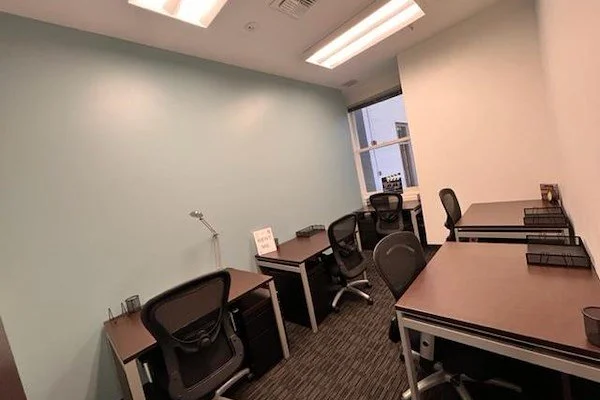How to Find Office Space for a Small Company
A corner office in TPC’s Ballard Coworking Space
Finding an office space to rent for a team of fewer than 15 employees can be difficult. The commercial real estate industry doesn’t dedicate much energy to servicing small businesses, especially if your company isn’t a buzzy startup that may grow quickly and represent large lease commissions in the future. When looking for office space for your small team, especially in a large city like Seattle, you should consider three alternative options to traditional leasing: executive suites, office space available for sublease, and private offices in coworking spaces.
Executive suites
The predecessor to coworking, executive suites have been around for decades. They provide cheap, no-frills small office space with flexible terms. These fully-furnished, ready-to-use offices are typically managed by an operating company, not a landlord. They offer short-term leases, flexibility in office size, and access to shared amenities and services, usually for extra fees. The most notable provider is IWG/Regus, which operates thousands of centers around the world.
Office space available for sublease
When a traditional office building tenant decides they would like to vacate all or part of their space, but still has term left on its master lease, they will offer it for sublease. The original lease document will remain intact and a new agreement can be signed between the tenant and the subtenant. Usually this will require landlord approval
Coworking spaces / Flex offices
Coworking operators offer higher-end workspaces including private offices and meeting rooms in addition to monthly coworking memberships, amenities and community activities and programming. For teams needing dedicate space, coworking operators provide private offices with access to additional shared space. These private office(s) are each dedicated to a single company, but by pooling resources with other small teams, teams get access to high end amenities usually reserved for large enterprises. Coworking spaces typically also offer flexible terms, networking opportunities, and a vibrant community.
An typical executive suite
A corner office building
The common area of a coworking space in Vancouver B.C.
What about traditional office leases?
Why omit traditional leases from this list? (e.g. signing a 5-10 year lease directly with a building owner)? Unless you’re in a small town, the disappointing reality is that your requirement probably represents too much work and not enough reward for brokers and landlords.
Traditional leases work best for teams of 20+ every-day employees that want to lock in for 5 or more years.
For hybrid teams, or everyday teams smaller than 20, other options are usually superior.
Traditional office brokers typically focus on larger clients and transactions because of how they are incentivized:
Commissions: Office brokers earn their commissions based on the total value of a signed lease, usually equal to $1-2 per square foot per year of term. Larger space requirements and longer terms result in more substantial commissions for brokers. Consequently, smaller team requirements may not generate sufficient financial incentives for brokers to dedicate their time and resources.
Time and Effort: Smaller team requirements often involve shorter lease terms and smaller office spaces. The process of identifying, negotiating, and finalizing smaller leases can be time-consuming for brokers compared to larger transactions. Similarly, once a lease is signed, given a fixed amount of space - say 10,000 square feet - a building owner will prefer to deal with one large tenant’s billing issues, maintenance requests, and buildout, then the needs of 10 separate tenants taking 1,000 square feet each.
Limited Inventory: Traditional office brokers typically have access to a portfolio of properties listed for lease or sale. The available inventory is usually skewed towards larger office spaces that attract bigger clients. Brokers prefer to focus their time on finding easily discoverable space through their usual channels, to spending time researching and hunting for options to offer smaller teams, especially if their compensation will be lower. This asymmetric work to payoff ratio deters them from actively pursuing smaller clients.
There are always exceptions, but for smaller teams, subleases, coworking spaces, flex offices, and executive suites generally provide better value. These options are designed to cater to smaller team requirements, offering cost-effective and plug-and-play office setups. Many brokers recognize this and will direct smaller leads towards coworking operators or flexible workspace providers.
A historic mixed-used building in Seattle’s Pioneer Square neighborhood
Factors to consider when considering alternatives to traditional office leasing:
Flexibility
Determine if you require a short-term agreement, the ability to adjust the size of your office footprint over time, or access to multiple locations within a network. Coworking spaces and executive suites offer greater flexibility compared to subleased space.
Can you sign a short term agreement (6 months - 1 year)? With coworking and executive suites, yes. With sublease space, usually not.
Can you flex your office footprint up and down in size as needed? With coworking and executive suites, yes. With sublease space, not usually, thought it may differ from deal to deal.
Can you add additional flex memberships for employees that won’t be using the office full time? With coworking spaces, yes. With executive suites maybe. With subleased space, no.
Can you access other locations in the network? With coworking and executive suites, yes. With sublease space, no.
Can you move in right away or do you need to wait for construction, permits etc.? With coworking and executive suites, you can usually move in the day you tour. With sublease space, this is sometimes possible if you are taking the space as-is, but if you want to change anything about the previous tenant’s build, you’ll have to budget time and money for permitting, and tenant improvement work.
Edge: executive suites and coworking (tied)
Economics
When it comes to budgeting, none of the three options strictly dominates the others in all scenarios. You’ll need to first define your use-case and calculate figures such as the percentage of hybrid, daily, or fully remote users you expect to use the office, your need for meeting spaces, amenities, first-class tech etc. If you don’t need a particularly attractive office or the amenities and extras that come with higher end coworking spaces, executive suites may be your cheapest option. If you’re willing to move into an office exactly the way another company customized it and can sign for a multi-year term, sublease space may prove most cost effective. Author’s note: this article was written in June of 2023. It’s entirely possible that the office market continues to soften, driven by post-pandemic WFH policies, leading to a price collapse for traditional office space. That is an existential risk to the coworking industry and could lead to traditional leases edging out alternative categories from a budgetary perspective in the future.
Load Factors: Sublease space and traditional office space have a load factor (sometimes called a “gross up”) which means a tenant pays for more space than they get to use. The rent per square foot number you are quoted may look very low at first, but it’s important to note that it’s not being multiplied by your usable square footage (the actual space in your office) or your rentable square footage (your usable square footage plus a percentage of building lobbies, common areas, hallways, parking garages etc.) The higher the load factor, the more your effective rental rate is. Most load factors range from 15-20% (1.15-1.20), but can climb as high as 30% (1.30).
Coworking spaces actually feature a sort of inverse load factor (you can use more space than you pay for, like conference rooms, kitchen, coworking areas and more). If you took a typical TPC office for four and then added in all meeting rooms, lounge areas and amenity spaces that you’d have access to, you’d actually get a load factor of .05. In other words, you could use 20x more space than the office you’d pay for. While if you calculated the price per square foot of just your private office, and ignored the rest of the accessible space, it would seem to be 5x more expensive than a comparable traditional office space, but when you adjust for load factor, they end up being roughly equivalent. Shopping based on price per square foot between a flex office/coworking and traditional office creates an apples to oranges comparison unless you clearly define the denominator (square footage) in the equation by adjusting for load.
Learn more in this side-by-side comparison guideServices and amenities: Coworking generally includes bundled services like mail service, custodial work, maintenance, on-site staff, fiber Internet, utilities, coffee, tea, bike storage, showers, and meeting room use. Executive suites usually charge separate for these some or all of these amenities. With a subleased space, the tenant will usually need to contract for these items independently or pay the original tenant* for services. Depending on the requirements of your company, these extras could represent $1,000 - $10,000 per month in additional charges.
*In traditional leases, the tenant pays for these pass-through expenses (sometimes called triple nets or NNN) either as part of their lease rate, in what’s called a “gross lease”, or separately, in the case of a “triple net lease” This is beyond the scope of this comparison, but is explained well in numerous other sources.
Edge: It depends
Customer Experience
Coworking spaces are typically run by operators and staff with a hospitality-focused, customer-first mindset and a dedication to building thriving communities.
Coworking and executive suite operators work to win your business each month.
Traditional office space and subleased space is owned by investors, managed by a professional property manager, leased to a tenant, who in turn is leasing it to a subtenant to save costs. The subtenant usually has very little contact with the owner or property manager, so it can be hard to get answers to questions or receive support when issues and problems arise
A traditional landlord has very little incentive to keep providing a high level of service once they have you locked into a 10 year lease that escalates each year. This doesn’t necessarily translate to bad service, but the incentive to provide top-notch service and hospitality is much stronger in the former scenario.
Edge: Coworking & Executive Suites
Environmental Footprint
If sustainability is a priority, coworking spaces tend to be more environmentally friendly compared to traditional office spaces. With a focus on quality builds and flexible furniture, coworking spaces minimize waste and promote long-term usability.
In a traditional office building and with sublease space, tenant improvements are designed to be disposed of.
Each time a new tenant takes over a space, the landlord rips out all of the previous tenants’s improvements, throws it in a landfill and starts over
This includes drywall, electrical, framing, mechanical systems, and many times even furniture
Coworking spaces generally invest in a quality build that lasts a decade or more and flexible furniture than can be used or stored depending on a customer’s needs
That being said, because subleased space is typically taken “as-is”, it’s significantly less carbon intensive than taking on a brand new lease, demolishing existing tenant improvements and starting a new buildout.
Edge: Three-way tie
Conclusion
What is the biggest benefit and drawback of subleasing office space?
#1 Benefit: Can be cheap, available for quick move-in
#1 Drawback: You must take it as-is, longer term without flexibility.
What biggest benefit and biggest drawback of Coworking Offices?
#1 Benefit: Flexibility without compromising on budget, services, or design
#1 Drawback: Not great for teams larger than 15-20 full-time employees
What is the biggest benefit and biggest drawback of Executive Suites?
#1 Benefit: Cost. They are usually the cheapest option.
#1 Drawback: Aesthetics. They are usually not inspirational or aspirational spaces.
Finding office space for a small team requires careful consideration of your present day requirements and, ideally, some analysis of how your needs may change over the next 3-5 years. What works great for one company will not necessarily work for another. Before you decide to pursue an executive suite, a sublease, or rent a private office in a coworking space, you should weigh flexibility, economics, customer experience, and environmental impact in your decision to find an office space that aligns with your team's goals and will support productivity, growth, and morale for years to come.
Helpful links
Office space for small teams in Seattle (TPC)
List of coworking spaces in Seattle
A financial comparison of traditional leases to coworking offices





